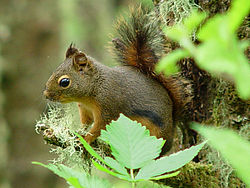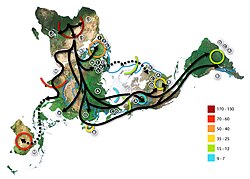Wildlife
Wildlife originally meant non-domesticated animal species.[1] It now includes all plants, fungi and other organisms which grow or live wild in an area without being introduced by humans.[2] Domesticating wild plant and animal species for human benefit has occurred many times all over the planet. It has had a big effect on the environment, both positive and negative.
Wildlife can be found in all ecosystems. Deserts, forests, rain forests, plains, grasslands, and other areas including the most developed urban sites, all have distinct forms of wildlife. Most scientists agree that wildlife around is affected by human activities. A garden is not a natural habitat, but it is full of genuine wildlife.
Wildlife Media
A lion (Panthera leo). Lions are an example of charismatic megafauna, a group of wildlife species that are especially popular in human culture.
A Douglas squirrel (Tamiasciurus douglasii)
Map of early human migrations, according to mitochondrial population genetics. Numbers are millennia before the present.
Deforestation and increased road-building in the Amazon Rainforest are a significant concern because of increased human encroachment upon wild areas, increased resource extraction and further threats to biodiversity.
References
- ↑ "What Is Wildlife?". IHEA. Archived from the original on 27 April 2012. Retrieved 14 July 2012.
- ↑ Usher M.B. 1986. Wildlife conservation evaluation: attributes, criteria and values. London, New York: Chapman and Hall. ISBN 978-94-010-8315-7.





